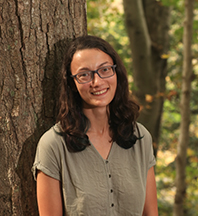Week of November 12, 2023 – November 18, 2023

by Catherine McLaughlin, Environmental Educator
We just started what is one of my current favorite lessons of the Baltimore Woods Nature in the City Program. When we go into third-grade classrooms for their first of three lessons this school year, we have a giant neon green suitcase that always piques interest in what we are talking about today. Inside that suitcase is a watershed model that we use to show students what happens to water bodies, using the specific example of Onondaga Lake, when it rains.
After adding brightly colored powders and sprinkles that represent road salt, fertilizers, litter, etc. on the landscape, students watch as rain washes the pollutants from across the city, making the water that flows into the lake extremely dirty. The demonstration paints a clear picture of what our actions and choices can do to our environment. But all is not lost, we do the demonstration again but this time we add green infrastructure just as Onondaga County Save the Rain did in Syracuse such as rain barrels, rain gardens, and green roofs to help collect that rainwater, preventing pollutants from getting into the lake. Now when we make it rain again on the model, the water is far cleaner due to the green infrastructure that we installed.
If you grew up near Syracuse like I did, you remember when there was a fishing ban, we couldn’t go into the water, and you could smell Onondaga Lake if the wind changed direction. A large mix of things happened here to cause the water to become so polluted. From wastewaters to industry, people caused destruction to this watershed. Now people are working to clean up the land and improve the watershed for years – rebuilding it for not only people, but wildlife as well. When you visit the lake today, we see more wildlife like eagles and lake sturgeon as well as people beginning to use the water again recreationally.
Our actions in the past changed Onondaga Lake for the worst. Our actions now are changing the lake for the future. No matter where we are in the world, humans can work to rebuild or restore what has been changed by us. Here at Baltimore Woods, we are actively working to help restore areas that used to be in agriculture, pasture, or excavation to forests and meadows that provide diverse habitats and bloom into ecosystems full of life. Thanks to the dedication of dozens of volunteers and our Land Stewardship Staff, we have been working to restore the preserve to maintain the overall health of the forest and for future generations to experience and explore.
Have you seen other areas that are being rebuilt? Or have you lent a helping hand to one?

